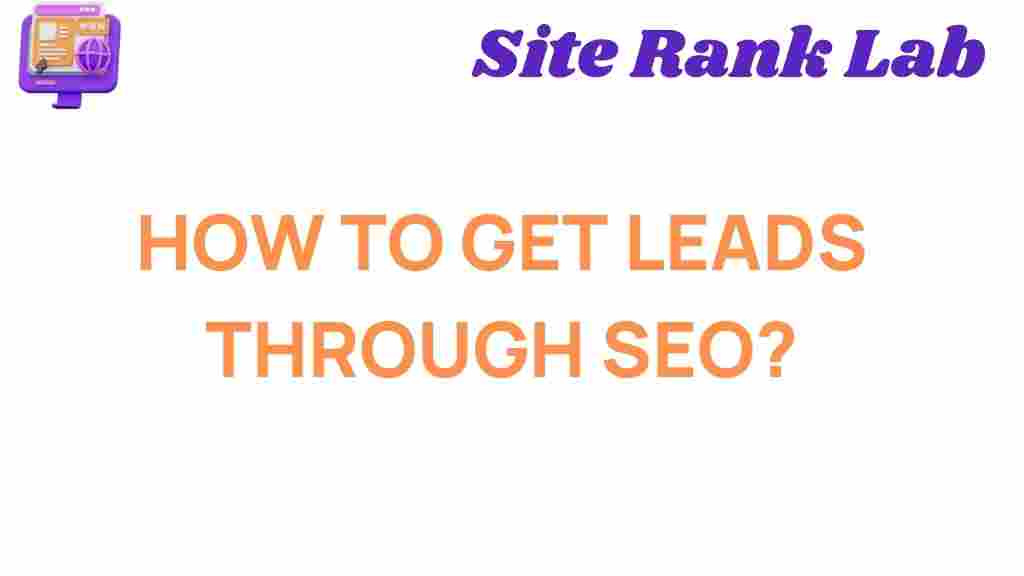Unleashing SEO: Your Secret Weapon for Generating Leads
In the fast-paced world of digital marketing, businesses are constantly seeking innovative ways to enhance their online visibility and drive website traffic. One of the most effective strategies for achieving these goals is mastering SEO (Search Engine Optimization). By focusing on SEO, you can significantly improve your search engine ranking, attract potential customers, and ultimately boost lead generation. In this comprehensive guide, we will explore how to harness the power of SEO to transform your lead generation efforts.
Understanding SEO and Its Importance in Digital Marketing
SEO is the process of optimizing your website to rank higher in search engine results pages (SERPs). This optimization involves various techniques, including keyword research, content strategy, and on-page and off-page SEO practices. Here are some reasons why SEO is crucial for your digital marketing strategy:
- Increased Online Visibility: Higher search engine rankings lead to greater visibility, making it easier for potential customers to discover your business.
- Cost-Effective Marketing: Compared to traditional advertising, SEO is a cost-effective way to generate leads and drive traffic.
- Enhanced User Experience: SEO practices often improve website usability, leading to better engagement and higher conversion rates.
Step-by-Step Process for Implementing an Effective SEO Strategy
To unleash the full potential of SEO for lead generation, follow this step-by-step process:
Step 1: Conduct Thorough Keyword Research
Keyword research is the foundation of any successful SEO strategy. Identify keywords that are relevant to your business and have a high search volume. Tools like Google Keyword Planner and SEMrush can help you discover valuable keywords. Aim to include your focus keyword, such as lead generation, in your research.
Step 2: Develop a Robust Content Strategy
Your content is one of the most critical aspects of SEO. Create high-quality, informative, and engaging content that incorporates your target keywords naturally. Consider the following types of content:
- Blog Posts: Regularly publish blog posts that address your audience’s pain points and interests.
- Infographics: Visual content can help simplify complex information and increase shareability.
- Videos: Video content is highly engaging and can significantly enhance user experience.
Remember to optimize your content for both search engines and users by including relevant keywords in headings, subheadings, and throughout the text.
Step 3: Optimize On-Page Elements
On-page SEO refers to the optimization of individual web pages to rank higher and earn more relevant traffic. Focus on the following elements:
- Title Tags: Use compelling title tags that include your target keywords.
- Meta Descriptions: Write concise meta descriptions that summarize your content and include keywords.
- Header Tags: Utilize header tags (H1, H2, H3) to structure your content effectively.
- Image Alt Text: Optimize images by adding descriptive alt text that incorporates relevant keywords.
Step 4: Enhance Off-Page SEO
Off-page SEO involves activities outside your website that impact your search engine ranking. Key strategies include:
- Backlink Building: Acquire high-quality backlinks from reputable websites to improve your site’s authority.
- Social Media Marketing: Promote your content on social media platforms to increase visibility and drive traffic.
- Guest Blogging: Write guest posts for other blogs in your niche, including links back to your website.
Step 5: Monitor and Analyze Your SEO Performance
Once you’ve implemented your SEO strategy, it’s essential to monitor its performance. Use tools like Google Analytics and Google Search Console to track key metrics such as website traffic, bounce rate, and conversion rates. This data will help you identify what’s working and what needs improvement.
Troubleshooting Common SEO Issues
Even with a solid SEO strategy, you may encounter challenges. Here are some common issues and how to troubleshoot them:
Issue 1: Low Search Engine Rankings
If your website isn’t ranking well, consider:
- Analyzing your keyword usage and ensuring you’re targeting the right keywords.
- Improving your content quality and relevance.
- Building more backlinks to enhance your site’s authority.
Issue 2: High Bounce Rate
A high bounce rate can indicate that users aren’t finding what they’re looking for. To reduce the bounce rate:
- Ensure your content is engaging and meets user intent.
- Improve page loading speed.
- Optimize for mobile devices.
Issue 3: Low Conversion Rates
If your website traffic is high but conversions are low, consider focusing on conversion optimization. This may include:
- Improving call-to-action (CTA) buttons.
- Streamlining the navigation process.
- Offering incentives like discounts or free trials.
Conclusion: The Long-Term Benefits of SEO for Lead Generation
In the competitive landscape of digital marketing, SEO stands out as a powerful tool for generating leads and driving website traffic. By implementing a well-structured SEO strategy that includes thorough keyword research, a robust content strategy, on-page and off-page optimization, and consistent performance monitoring, you can significantly enhance your online visibility and search engine ranking.
With persistence and dedication, the benefits of SEO will compound over time, leading to a steady stream of leads and conversions. So, don’t underestimate the power of SEO—embrace it as your secret weapon in the battle for online success.
For more insights into enhancing your digital marketing strategy, check out this comprehensive guide on content marketing. Additionally, consider exploring resources on SEO best practices from Moz.
This article is in the category SEO and created by SiteRankLab Team
